Drag queen
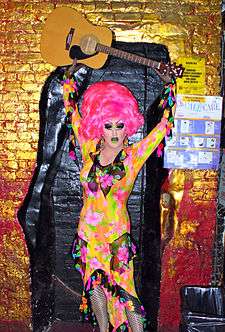
| Cross-dressing |
|---|
|
Key elements |
|
Modern drag culture |
|
Sexual attraction to cross-dressers |
|
Other aspects |
|
Organizations |
Drag queens are people, usually male, who dress in women's clothing and often act with exaggerated femininity and in feminine gender roles for the purpose of entertainment. Often, they exaggerate characteristics like make-up and eyelashes for dramatic, comedic or satirical effect. Drag is closely associated with gay men and gay culture. Drag queens vary widely by class and culture and dedication, from professionals who star in films to people who try drag very occasionally.
There are many reasons people do drag, from self-expression to the performing and entertaining in the "high drag". Drag queen activities among stage and street performers may include lip-syncing performances, live singing, dancing, participating in events such as gay pride parades, drag pageants, or at venues such as cabarets and discotheques.
Terminology, scope and etymology
The origin of the term is uncertain;[1] the first recorded use of drag in reference to actors dressed in women's clothing is from 1870.[2] Drag queens are typically cisgender gay men, but there are drag queens of all different sexual orientations and genders,[3] including trans women who perform as drag queens[4][5][6] (sometimes termed trans queens),[7] such as Monica Beverly Hillz[4][5] and Agnes Moore, known by her stage name Peppermint,[6] and cisgender women[8] who do, sometimes termed faux queens.[9] Drag queens' counterparts are drag kings, women who dress in exaggeratedly masculine clothing; men who dress like drag kings are sometimes termed faux kings.
Female impersonator

Another term for a drag queen is female impersonator.[10] Although this is still used, it is sometimes regarded as inaccurate, because not all contemporary drag performers are attempting to pass as women. Female impersonation has been and continues to be illegal in some places, which inspired the drag queen José Sarria to hand out labels to his friends reading, "I am a boy", so he could not be accused of female impersonation.[11] American drag queen RuPaul once said, "I do not impersonate females! How many women do you know who wear seven-inch heels, four-foot wigs, and skintight dresses?" He also said, "I don't dress like a woman; I dress like a drag queen!".[12]
Alternative terms
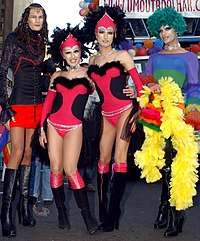
Some drag queens may prefer to be referred to as "she" while in drag and desire to stay completely in character.[13] Other drag performers, like RuPaul, seem to be completely indifferent to which pronoun is used to refer to them. In his words, "You can call me he. You can call me she. You can call me Regis and Kathie Lee; I don't care! Just so long as you call me."[14]
Drag queens are sometimes called transvestites, although that term also has many other connotations than the term drag queen and is not much favored by many drag queens themselves.[15] The term tranny has been adopted by some drag performers, notably RuPaul,[16] and the gay male community[17] in the United States, but it is considered offensive to most transgender and transsexual people.[18]
Many drag performers refer to themselves as drag artists, as opposed to drag queens, as contemporary forms of drag have become nonbinary.[19][20]
History of drag
Europe
Pantomime dames
In the late 1800s to the mid-1900s, pantomime dames became a popular form of female impersonation in Europe.[21] This was the first era of female impersonation in Europe to use comedy as part of the performance, as opposed to the serious Shakespearean tragedies and Italian operas.[22] The dame became a stock character with a range of attitudes from "charwoman" to "grande dame" that was mostly used for improvisation.[22] The most famous and successful pantomime dame was Dan Leno. After the World Wars, the theater and movie scenes were changing and the use of pantomime dames was on the decline.[21]
America

Minstrel shows
Development of the drag queen in the United States started with the development of the blackface minstrel show.[23] Originally the performers would only mock African American men, but as time went on they found it amusing to mock African American femininity as well. They performed in comedic skits, dances, and "wench" songs.[24] These minstrel shows and their "wench players" were used by white men to both mock and oppress women and African Americans.[24]
Vaudeville and female impersonators
.jpg)
The broad comedic stylings of the minstrel shows helped develop the vaudeville shows of the late 1800s to the early 1900s.[23] With this shift, the "wench players" became "prima donnas", and became more elegant and refined, while still retaining their comedic elements.[24] While the "wenches" were purely American creations, the "prima donnas" were inspired by both America and European cross-dressing shows, like Shakespearean actors and castrati.[24] With the United States shifting demographics, including the shift from farms to cities, Great Migration of African Americans, and an influx of immigrants, vaudeville's broad comedy and music expanded the audience from minstrelsy.[23] With vaudeville becoming more popular, it allowed female impersonators to become popular as well. Many female impersonators started with low comedy in vaudeville and worked their way up to perform as the prima donna.[21] Famous female impersonator Julian Eltinge found success in this and eventually made his way to the broadway stage performing as a woman.[21] At this time being a female impersonator was seen as something for the straight white male, and any deviation was punished.[23] Connection with sex work and homosexuality eventually lead to the decline of vaudeville during the Progressive Era.[23] Both the minstrelsy and vaudeville eras of female impersonation led to an association with music, dance, and comedy that still lasts today.[21]
Night clubs
In the early to mid-1900s, female impersonation had become tied to the LGBT community and thus criminality, so it had to change forms and locations.[23] It moved from being popular mainstream entertainment to something done only at night in disreputable areas, such as San Francisco's Tenderloin.[23] Here female impersonation started to evolve into what we today know as drag and drag queens.[22] Drag queens such as José Sarria[25] and Aleshia Brevard[26] first came to prominence in these clubs.[23] People went to these nightclubs to play with the boundaries of gender and sexuality and it became a place for the LBGT community, especially gay men, to feel accepted. As LGBT culture has slowly become more accepted in American society, drag has also become more, though not totally, acceptable in today's society.[22]
Protests
The Cooper Do-nuts Riot was a May 1959 incident in Los Angeles in which drag queens, lesbians, transgender women, and gay men rioted; it was one of the first LGBT uprisings in the United States.[27]
The Compton's Cafeteria riot, which involved drag queens and others, occurred in San Francisco in 1966.[28] It marked the beginning of transgender activism in San Francisco.[28]
On March 17, 1968, in Los Angeles, to protest entrapment and harassment by the LAPD, two drag queens known as "The Princess" and "The Duchess" held a St. Patrick's Day party at Griffith Park, a popular cruising spot and a frequent target of police activity. More than 200 gay men socialized through the day.[29]
Drag queens were also involved in the Stonewall riots, a series of spontaneous, violent demonstrations by members of the LGBT community against a police raid that took place in the early morning hours of June 28, 1969, at the Stonewall Inn, located in the Greenwich Village neighborhood of Manhattan, New York City. The riots are widely considered to be the catalyst for the gay liberation movement and the modern fight for LGBT rights in the United States.[30][31]
During the summer of 1976, a restaurant in Fire Island Pines, New York, denied entry to a visitor in drag named Terry Warren. When Warren's friends in Cherry Grove heard what had happened, they dressed up in drag, and, on July 4, 1976, sailed to the Pines by water taxi. This turned into a yearly event where drag queens go to the Pines, called the Invasion of the Pines.
Story time in libraries
In December 2015, Radar Productions and Michelle Tea developed the concept of "Drag Queen Story Hour".[32] Launched at the San Francisco Public Library, Drag Queen Story Hour was adopted by the Brooklyn Public Library in the summer of 2016, and has since traveled to various libraries, museums, bookstores, and recreation centers, and parks across the United States, Canada, and the United Kingdom.[33]
Drag queen names
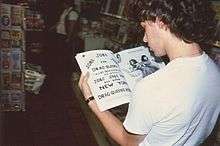
A drag queen may either pick or be given a drag name by a friend, sometimes called a "drag mother", the so named thus becoming known as a "drag daughter".[34] Drag mothers and drag daughters have a mentor-apprentice relationship. Drag 'families' were part of ball culture and drag 'houses' until the 1960s.[35]
Art of drag
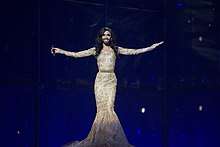
The process of getting into drag or into character can take hours. A drag queen may aim for a certain style, celebrity impression, or message with their look. Hair, make-up, and costumes are the most important essentials for drag queens.[36] Drag queens tend to go for a more exaggerated look with a lot more makeup than a typical feminine woman would wear.
Some people do drag simply as a means of self-expression,[3][37] but often drag queens (once they have completed a look) will go out to clubs and bars and perform a "drag show."[38] Many drag queens do dress up for money by doing different shows, but there are also drag queens that have full-time jobs but still enjoy dressing up in drag as a hobby.[39]
Many parts of the drag show, and of the drag queens' other intellectual properties, cannot be protected by intellectual property law. To substitute the lack of legal protection, drag queens revert to social norms in order to protect their intellectual property.[40]
In entertainment
Drag shows and venues
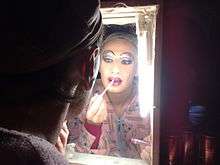
A drag show is an entertainment consisting of a variety of songs, monologues or skits featuring either single performers or groups of performers in drag meant to entertain an audience. They range from amateur performances at small bars to elaborately staged theatrical presentations. Many drag shows feature performers singing or lip-synching to songs while performing a pre-planned pantomime, or dancing. The performers often don elaborate costumes and makeup, and sometimes dress to imitate various famous female singers or personalities. Some events are centered around drag, such as Southern Decadence where the majority of festivities are led by the Grand Marshals, who are traditionally drag queens.[41]
In film
- 1933 – Victor and Victoria, a German film about drag queens working in musical entertainment, starring Renate Müller and Hermann Thimig.
- 1934 – George and Georgette, the French-language version of Victor and Victoria.
- 1935 – First a Girl, the English-language version of Victor and Victoria.
- 1937 – Upstairs (Piętro wyżej), the first Polish drag queen style movie, starring Eugeniusz Bodo.
- 1953 – Glen or Glenda, one of the most famous cult classics of Ed Wood, starring himself as Glen and Glenda.
- 1954 – White Christmas, classic of Irving Berlin, with Danny Kaye and Bing Crosby singing in "drag".
- 1957 – Victor and Victoria, a German remake of the 1933 film.
- 1959 – Some Like It Hot, starring Marilyn Monroe, Tony Curtis and Jack Lemmon.
- 1967 – Thoroughly Modern Millie, an American musical starring Julie Andrews, James Fox, Mary Tyler Moore, Carol Channing, John Gavin, and Beatrice Lillie, notable where Fox's character dresses in drag in order to find out what happened to Tyler Moore's character.
- 1969 – Funeral Parade of Roses starring Peter
- 1972 – Pink Flamingos starring Divine
- 1975 – The Rocky Horror Picture Show, with Tim Curry as a cross-dressing bi-sexual, Susan Sarandon, Barry Bostwick
- 1977 – Outrageous!, starring Craig Russell as a fictionalized version of himself
- 1978 – La cage aux folles a 1978 Franco-Italian film adaptation of the play of the same name starring Ugo Tognazzi and Michel Serrault.
- 1979 – The Rose starring Bette Midler, notable for a scene in which Midler's character Mary Rose Foster performs a duet on stage in a drag club with a drag queen (played by Kenny Sacha) who is impersonating Midler as Foster.
- 1982 – Tootsie starring Dustin Hoffman, Jessica Lange, and Teri Garr
- 1982 – Victor/Victoria, an American remake of the 1933 film, starring Julie Andrews
- 1985 – Lust in the Dust starring Divine
- 1988 – Hairspray starring Divine (Remade in 2007 starring John Travolta)
- 1988 – Torch Song Trilogy starring Harvey Fierstein, Anne Bancroft and Matthew Broderick
- 1990 – Paris Is Burning a documentary film directed by Jennie Livingston. It chronicles the ball culture of New York City and the gay and transgender community involved in it. It centers around African American and Latino drag culture surrounding communities such as Harlem in the 80s.
- 1991 – Vegas in Space starring Doris Fish, Miss X, Ginger Quest, and introducing 'Tippi'
- 1993 – Mrs. Doubtfire starring Robin Williams, Sally Field, and Pierce Brosnan.
- 1994 – The Adventures of Priscilla, Queen of the Desert starring Terence Stamp, Hugo Weaving, and Guy Pearce
- 1995 – To Wong Foo, Thanks for Everything! Julie Newmar starring Wesley Snipes, Patrick Swayze, and John Leguizamo (cameo by RuPaul)
- 1995 – Wigstock: The Movie documentary film focusing on the annual drag music festival that had been held in New York City's East Village during the 1980s and 1990s. Includes appearances by Lady Bunny, Crystal Waters, Deee-Lite, Jackie Beat, Debbie Harry, Leigh Bowery, Joey Arias and the Dueling Bankheads. The film also captures a performance by RuPaul at the height of his mainstream fame during the 1990s.[42]
- 1996 – The Birdcage starring Robin Williams, Nathan Lane, Gene Hackman and Dianne Wiest (a remake of the 1978 film La Cage aux Folles, based on the 1973 play)
- 1996 – The Nutty Professor starring Eddie Murphy.
- 1998 – Midnight in the Garden of Good and Evil starring John Cusack, Kevin Spacey and starring as herself Lady Chablis
- 1999 – Flawless starring Philip Seymour Hoffman and Robert De Niro
- 2000 – Big Momma's House starring Martin Lawrence
- 2001 – Hedwig and the Angry Inch starring John Cameron Mitchell
- 2002 – Sorority Boys
- 2003 – Girls Will Be Girls directed by Richard Day, starring Miss Coco Peru (Clinton Leupp), Evie Harris (Jack Plotnick), and Varla Jean Merman (Jeffery Roberson).
- 2003 – Die, Mommie, Die! starring Charles Busch, Jason Priestley, Philip Baker Hall, and Natasha Lyonne
- 2004 – Connie and Carla starring Nia Vardalos, Toni Collette, and David Duchovny
- 2004 – White Chicks starring Shawn Wayans and Marlon Wayans
- 2005 – Kinky Boots starring Joel Edgerton, Chiwetel Ejiofor, Sarah-Jane Potts, and Nick Frost
- 2005 – Rent
- 2006 – The Curiosity of Chance starring Tad Hilgenbrink and Brett Chukerman
- 2007 – St. Trinian's starring Rupert Everett as Camilla Fritton, the headmistress of the school.
- 2011 – Big Mommas: Like Father Like Son starring Martin Lawrence and Brandon T. Jackson
- 2012 – Albert Nobbs starring Glenn Close and Janet McTeer
- 2015 – Dressed As A Girl starring Johnny Woo
- 2016 – Absolutely Fabulous: The Movie starring Joanna Lumley and Jennifer Saunders, featuring Jodie Harsh and La Voix amongst others
- 2016 – Iru mugan (Indian Tamil movie) starring Vikram, Nayanthara, Nithya Menen and Nasser in the lead roles.
- 2016 – Hurricane Bianca starring Bianca Del Rio, Willam Belli, Shangela Laquifa Wadley and appearances by RuPaul, Joslyn Fox and Alyssa Edwards[43]
In music
While some male music celebrities wear exaggerated feminine clothing as part of their show, they are not necessarily drag queens. For example, Boy George wears drag queen style clothes and cosmetics but he once stated he was not a drag queen.[44] However, RuPaul[45] is a professional drag queen performer and singer.
Examples of songs where lyrics refer to drag queens:
- "Lola" by The Kinks (or possibly a transgender woman)
- "Dude (Looks Like a Lady)" by Aerosmith
- "The Lady is a Vamp" by Spice Girls
- "Ballad of Cleo and Joe" by Cyndi Lauper
- "King for a Day" by Green Day
- "Cherry Lips" by Garbage
- "Born This Way" by Lady Gaga
- "Verbatim" by Mother Mother
- "He's a Woman She's a Man" by Scorpions
- "Pretty Lady" by Ke$ha & Detox Icunt
- "Andrew in Drag" by The Magnetic Fields
- "Rise Like a Phoenix" by Conchita Wurst (Represented Austria at the 2014 Eurovision Song Contest and won)
- "Divine" by Antony and the Johnsons
- "The End." in the album The Black Parade by My Chemical Romance
- "Drag Queen" by The Strokes
- "LGBT" by cupcaKke
- "C.L.A.T" by Aja, Peppermint, Sasha Velour and Alexis Michelle
In television
What Would You Do?, airing since early 2008, has had episodes featuring drag queens.[46][47]
In mid-2008, RuPaul began producing RuPaul's Drag Race, a reality television game show which began airing in February 2009. The premise of the program has several drag queens compete to be selected by RuPaul and a panel of judges as "America's next drag superstar". It inspired the similar spin-off shows RuPaul's Drag U and RuPaul's Drag Race: All Stars.
In 2018, Celebrity Big Brother featured Queen Shane Jenek (drag name Courtney Act) as one of its contestants, placing first in the season with 49.43% of the public vote.[48]
In 2018, American Idol featured a drag queen, Adam Sanders (drag name Ada Vox) as one of its contestants.[49] He made it to the top ten.[49]
Also in 2018, So You Think You Can Dance featured Jay Jackson (drag name Laganja Estranja) as one of its contestants.[50] He finished in eighth place.
In education
While drag queens have a prevalent status as entertainers, they play a role in educating people on gender roles and stereotyping. Professor Stephen Schacht of Plattsburgh State University of New York began introducing his and his students experiences of attending a Drag Show to his gender/sexualities class to challenge his students ideas of dichotomy. Over time he began inviting students to attend with him. He gathered from his students that after attending the drag show they had a new appreciation for gender and sexuality and often become very vocal about their new experiences in the classroom.[51]
Societal reception
Drag has come to be a celebrated aspect of modern gay life.[52] Many gay bars and clubs around the world hold drag shows as special parties. Several "International Drag Day" holidays have been started over the years to promote the shows. In the U.S. Drag Day is typically celebrated in early March.
A televised drag competition, RuPaul's Drag Race, is the most successful program on the Logo television network. In 2016, the show won a Primetime Emmy Award for Outstanding Host for a Reality or Reality-Competition Program.[53] In 2018, the show became the first show to win a Primetime Emmy Award for Outstanding Reality-Competition Program and a Primetime Emmy Award for Outstanding Host for a Reality or Reality-Competition Program in the same year.[54][55][56] However, its winners and contestants have yet to receive the same level of recognition as mainstream reality show contestants.
RuPaul received a star on the Hollywood Walk of Fame for his contributions to the television industry on March 16, 2018, making him the first drag queen to be given such an award.[57][58]
See also
- Cover Girl
- Cross-dressing
- Drag pageantry
- Finocchio's Club
- Imperial Court System
- Kiki DuRane
- List of drag queens
- List of transgender-related topics
- Pansy Craze
- Sisters of Perpetual Indulgence
- The Adventures Of Priscilla: Queen Of The Desert
- The Pink Mirror, a film on Indian drag queens
- Vegas in Space
- Wanda Wisdom
- Wild Side Story
| Wikimedia Commons has media related to Drag queen. |
Notes
- ↑ Baroni, Monica (2012) [1st pub. 2006]. "Drag". In Gerstner, David A. Routledge International Encyclopedia of Queer Culture. New York: Routledge. p. 191. ISBN 978-1-136-76181-2. OCLC 815980386. Retrieved 27 April 2018.
- ↑ Felix Rodriguez Gonzales (26 June 2008). "The feminine stereotype in gay characterization: A look at English and Spanish". In María de los Ángeles Gómez González; J. Lachlan Mackenzie; Elsa M. González Álvarez. Languages and Cultures in Contrast and Comparison. Pragmatics & beyond new series v 175. Philadelphia: John Benjamins Publishing Company. p. 231. ISBN 978-90-272-9052-6. OCLC 860469091. Retrieved 29 April 2017.
- 1 2 O'Brien, Jennifer (January 30, 2018). "The Psychology of Drag". Psychology Today. Retrieved August 7, 2018.
- 1 2 Levin, Sam (March 8, 2018). "Who can be a drag queen? RuPaul's trans comments fuel calls for inclusion". The Guardian. Retrieved August 7, 2018.
- 1 2 Beverly Hillz, Monica (March 9, 2018). "I'm a trans woman and a drag queen. Despite what RuPaul says, you can be both". The Washington Post. Retrieved August 7, 2018.
- 1 2 Kirkland, Justin (March 22, 2018). "Peppermint Is Taking on a New Fight for the Trans Community". Esquire. Retrieved August 7, 2018.
- ↑ Framke, Caroline (March 7, 2018). "How RuPaul's comments on trans women led to a Drag Race revolt — and a rare apology". Vox. Retrieved August 7, 2018.
- ↑ Coull, Jamie Lee (2015). Faux Queens: an exploration of gender, sexuality and queerness in cis-female drag queen performance (PhD). Curtin University.
- ↑ Nicholson, Rebecca (July 10, 2017). "Workin' it! How female drag queens are causing a scene". The Guardian. Retrieved August 7, 2018.
- ↑ When Cross Dressing was a crime http://www.advocate.com/arts-entertainment/books/2015/03/12/tbt-when-cross-dressing-was-crime?page=full
- ↑ ">> social sciences >> Sarria, José". glbtq. 1923-12-12. Archived from the original on 2013-12-03. Retrieved 2014-03-01.
- ↑ Dr. Susan Corso (April 15, 2009). Drag Queen Theology. Retrieved: April 1, 2018.
- ↑ "Understanding Drag". transequality.org. National Center for Transgender Equality. 2017-04-28. Retrieved 2018-03-13.
- ↑ Rupaul (June 1995), Lettin' It All Hang Out: An Autobiography, Hyperion Books, p. 139
- ↑ Ford, Zack. "The Quiet Clash Between Transgender Women And Drag Queens." ThinkProgress, 25 June 2014. Web. 9 September 2017.
- ↑ Spargo, Chris (2012-01-15). "NEW: RuPaul's 'Tranny' Conroversy". NewNowNext. Retrieved 2013-10-06.
- ↑ Musto, Michael (2010-11-12). "Is "Tranny" So Bad?". Blogs.villagevoice.com. Archived from the original on 2013-10-04. Retrieved 2013-10-06.
- ↑ "Is 'Tranny' Offensive?". The Bilerico Project. 2008-09-09. Retrieved 2013-10-06.
- ↑ Knauf, Ana Sofia. "Person of Interest: Arson Nicki". The Stranger. Tim Keck. Retrieved 1 July 2018.
- ↑ Lam, Teresa. "Getting to Know Non-Binary Drag Artist Rose Butch". Hypebae. Retrieved 1 July 2018.
- 1 2 3 4 5 Moore, F. Michael. Drag!: Male and Female Impersonators on Stage, Screen, and Television: An Illustrated World History. Jefferson, N.C: McFarland & Company, 1994.
- 1 2 3 4 Baker, Roger. Drag: A History of Female Impersonation in the Performing Arts. NYU Press, 1994.
- 1 2 3 4 5 6 7 8 Boyd, Nan Alamilla (2003), Wide-Open Town, University of California Press
- 1 2 3 4 Bean, Annemarie (2001), Female Impersonation in Nineteenth-Century American Blackface Minstrelsy, New York University
- ↑ "The Drag Times." Drag, 1980. Archives of Sexuality.
- ↑ "Finocchio's 1961 Revue One of LaMonte's Best". The Times. San Mateo, California. February 3, 1961. p. 23. Retrieved May 11, 2017.
- ↑ Moffitt, Evan (31 May 2015). "10 Years Before Stonewall, There Was the Cooper's Donuts Riot". Out Magazine. Here Media Inc. Retrieved 30 June 2017.
- 1 2 Boyd, Nan Alamilla (2004). "San Francisco" in the Encyclopedia of Lesbian, Gay, Bisexual and Transgendered History in America, Ed. Marc Stein. Vol. 3. Charles Scribner's Sons. pp. 71–78.
- ↑ Witt, Lynn, Sherry Thomas and Eric Marcus (eds.) (1995). Out in All Directions: The Almanac of Gay and Lesbian America, pg. 210. New York, Warner Books. ISBN 0-446-67237-8.
- ↑ National Park Service (2008). "Workforce Diversity: The Stonewall Inn, National Historic Landmark National Register Number: 99000562". US Department of Interior. Retrieved January 21, 2013.
- ↑ "Obama inaugural speech references Stonewall gay-rights riots". North Jersey Media Group Inc. January 21, 2013. Archived from the original on July 23, 2013. Retrieved January 21, 2013.
- ↑ Lamarche, Una (19 May 2017). "Drag Queen Story Hour Puts the Rainbow in Reading". The New York Times. Retrieved 22 June 2017.
- ↑ "About Drag Queen Story Hour". Drag Queen Story Hour -- drag queens reading stories to children in libraries, schools, and bookstores. Drag Queen Story Hour. Retrieved 22 June 2017.
- ↑ Rupp, Leila J.; Taylor, Verta A. (2003-05-15). Drag Queens at the 801 Cabaret. University of Chicago Press. p. 168. ISBN 9780226731582.
- ↑ "The Rainbow History Project: Drag in DC". Rainbow History Project. 2000–2007. Archived from the original on 2014-06-14. Retrieved 2007-10-20.
- ↑ "Dude to Diva: How to Become a Drag Queen | The Chronicle". Dukechronicle.com. Retrieved 2014-03-01.
- ↑ Jackson, Angie (May 20, 2015). "Performing in drag is all about self-expression for some West Michigan men". Retrieved August 7, 2018.
- ↑ King, Mark. "A working life: the drag queen | Money". The Guardian. Retrieved 2014-03-01.
- ↑ "Tom Bartolomei: 10 Myths About Drag Queens". Huffingtonpost.com. 2013-04-01. Retrieved 2014-03-01.
- ↑ Sarid, Eden (2014). "Don't Be a Drag, Just Be a Queen – How Drag Queens Protect their Intellectual Property without Law". Florida International University Law Review. 10 (1). Retrieved 8 April 2016.
- ↑ "Southern Decadence Official Website". Southerndecadence.net. 2013-09-03. Retrieved 2014-03-01.
- ↑ Ebert, Roger. "Wigstock: The Movie Movie Review (1995) | Roger Ebert". www.rogerebert.com. Retrieved 13 October 2018.
- ↑ "Hurricane Bianca (2016)".
- ↑ "Boy George: "I'M Not A Dragqueen!" At YouTube". YouTube.com. 2007-12-27. Retrieved 2014-03-01.
- ↑ Rupaul Biography Drag Queen Diaries
- ↑ https://abcnews.go.com/WhatWouldYouDo/video/parents-disapprove-drag-queen-sons-eat-56275264
- ↑ https://abcnews.go.com/WhatWouldYouDo/drag-queens-harassed-cafe/story?id=12332984
- ↑ "Courtney Act crowned winner of Celebrity Big Brother". Digital Spy. 2018-02-02. Retrieved 2018-08-14.
- 1 2 "Facts About Ada Vox From "American Idol" You Need to Know". Goodhousekeeping.com. 2018-04-25. Retrieved 2018-06-01.
- ↑ "'Drag Race' Star Laganja Estranja Shows Off Sickening Moves on 'So You Think You Can Dance'". billboard.com. 2018-06-04. Retrieved 2018-06-08.
- ↑ "Browse journals by subject". Tandfonline.com. Retrieved 2018-06-01.
- ↑ Sarid, Eden (2014). "Don 't Be a Drag, Just Be a Queen—How Drag Queens Protect their Intellectual Property without Law". Florida International University Law Review. 10 (1): 142.
- ↑ "RuPaul's Drag Race". Television Academy. Retrieved 2016-09-28.
- ↑ Billboard. "'RuPaul's Drag Race's Emmys Win: See The Best Reactions". Billboard. Retrieved 2018-09-19.
- ↑ "Nominees/Winners | Television Academy". Emmys.com. Retrieved 2018-09-19.
- ↑ "Nominees/Winners | Television Academy". Emmys.com. Retrieved 2018-09-19.
- ↑ France, Lisa Respers (23 June 2017). "Hollywood Walk of Fame Class of 2018 revealed". CNN. Retrieved 21 February 2018.
- ↑ "RuPaul Is the First Drag Queen to Get a Star on the Hollywood Walk of Fame".
External links
| Look up female impersonator in Wiktionary, the free dictionary. |
| Look up drag queen in Wiktionary, the free dictionary. |
